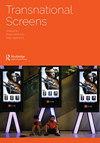Invisible Transnationalism: Iranian New Wave and its Influences on the New Marathi Film
IF 0.4
0 FILM, RADIO, TELEVISION
引用次数: 1
Abstract
ABSTRACT The article presents a critical mapping of invisible or subterranean transnationalism in the context of two geo-spatially distant cinemas. Interrogating the specific textual instances of the new Marathi film, I demonstrate that its narrative aesthetics has been significantly influenced by the New Iranian Cinema. The New Marathi film, which has emerged after Shwaas (2004), carries an unmistakable reworking of several Iranian films. Apart from certain productions that have children as their protagonists, several films like Valu (2009), Jhing Chik Jhing (2010), etc. derive their fundamental narrative premise from the minimalist plots of Iranian films like The Wind Will Carry Us, Children of Heaven, and The White Balloon. This, however, is circumscribed by the circulation of Iranian films through pirated DVDs, pirate networks, and peer-to-peer sharing. The article forwards two notions for invisible transnationalism: a) the valorization of Iranian films by Marathi filmmakers as an ideological remapping for narrative expressivity, and b) how this shapes the historical juncture defining the new-ness of the Marathi film.看不见的跨国主义:伊朗新浪潮及其对马拉地新电影的影响
本文在两个地理空间上遥远的电影院的背景下,对无形或地下的跨国主义进行了批判性的映射。通过对马拉地新电影的具体文本实例的考察,我发现其叙事美学受到了新伊朗电影的显著影响。这部新马拉地电影是在2004年的《沙瓦斯》之后出现的,它无疑是对几部伊朗电影的重新制作。除了一些以儿童为主角的作品外,《Valu》(2009)、《Jhing Chik Jhing》(2010)等几部电影的基本叙事前提都是来自伊朗电影《风将载我们》、《天堂的孩子》和《白气球》的极简主义情节。然而,这受到了伊朗电影通过盗版dvd、盗版网络和点对点共享的流通的限制。本文提出了两个无形跨国主义的概念:a)马拉地电影制作人将伊朗电影作为叙事表现力的意识形态重新映射,以及b)这如何塑造定义马拉地电影新颖性的历史节点。
本文章由计算机程序翻译,如有差异,请以英文原文为准。
求助全文
约1分钟内获得全文
求助全文
来源期刊

Transnational Screens
Arts and Humanities-Visual Arts and Performing Arts
CiteScore
0.60
自引率
0.00%
发文量
23
 求助内容:
求助内容: 应助结果提醒方式:
应助结果提醒方式:


